The purpose of the article is to inspire and educate those who are considering adding decorative exposed ceiling beams to their space, as well as to give practical advice on how to choose the right beam design and installation method adding decorative ceiling exposed ceiling beams to dream home , for according to their needs.
Solid wood exposed ceiling beams, or other exposed beams or ceiling beams are structural elements, usually made from solid wood or, metal, or concrete, that are used to support the weight of the ceiling or roof. In home decor, these exposed beams, ceiling beams, or solid wood beams are often exposed and used as decorative elements to add visual interest and depth to a room’s design.
Ceiling Beam Ideas
Coffered Ceiling Beams
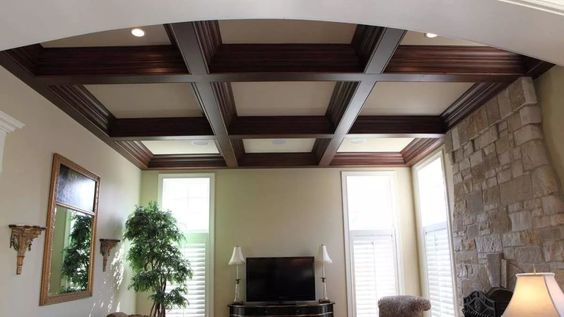
Coffered ceiling beams in the front bedroom, living room or master bedroom, are the decorative ceiling beams, fireplace or wall elements created by placing beams in a square or rectangular shape. Each square or rectangle formed by the beams is called a caisson.
This type of decorative ceiling beams, fireplace or wall part, or solid wood beams, is common in classical and traditional interior styles and can be made of different materials such as wood, plaster, polyurethane, and others.
Coffered ceiling beams can add visual interest and uniqueness to any room, or dining area living room or space, especially in large rooms with high ceilings. They have light wood, and false beams can be used to create a high ceiling in a dining room, room, or room, to give the illusion of a higher ceiling, or to hide flaws in the wall or ceiling surface.
Vaulted Ceiling Beams
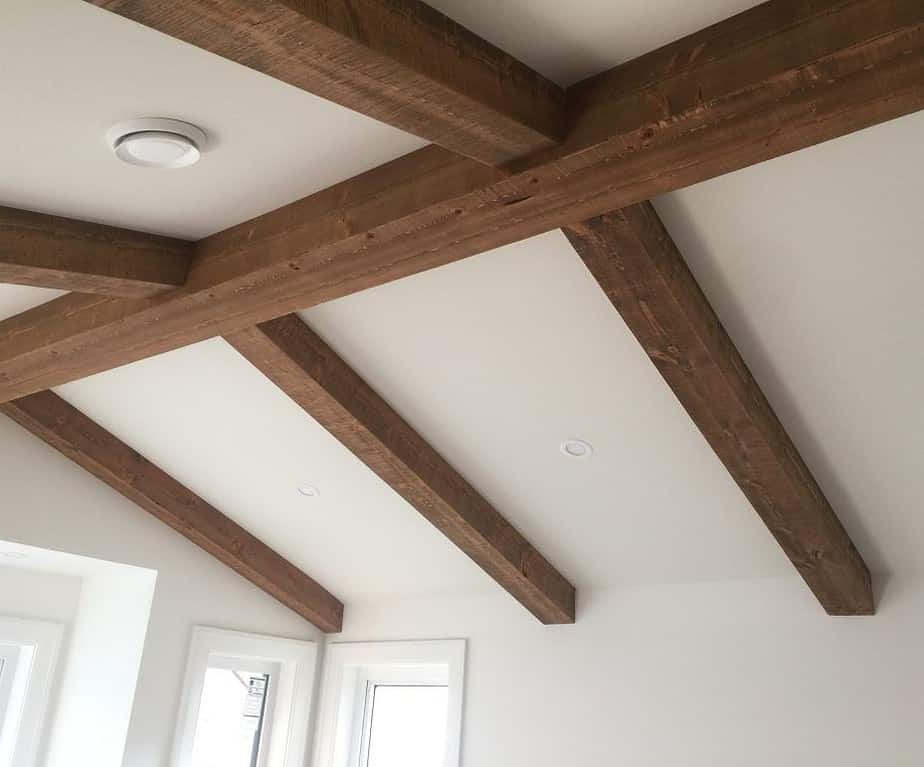
Vaulted ceiling beams in the bedroom and living room add elegance and beauty to any room.The beams of the vaulted ceiling not only give a sense of openness, light, and spaciousness to the space, but also add a unique architectural element that draws the eye upward.
Such exposed ceiling beams not only give a sense of open natural light and spaciousness to the bedroom, but also add a unique architectural element that draws the eye upward.
Whether you prefer the rustic look or modern style, vaulted ceiling beams are a stylish, modern and timeless choice.
Unfinished Ceiling Beams
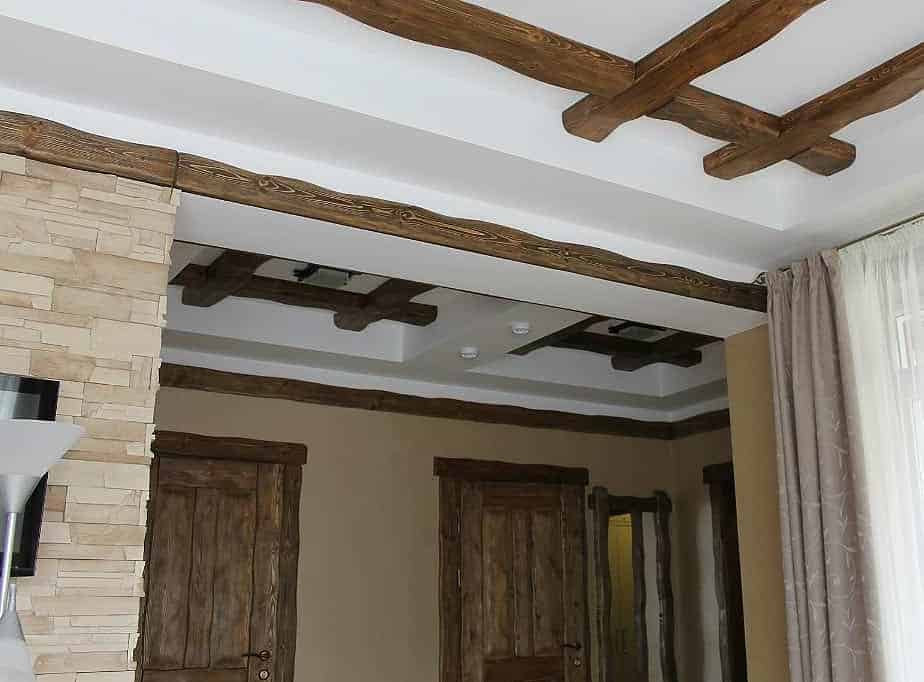
Wavy ceiling beams on a wooden dining table in the living room and dining room are a decorative element in a modern, home that is used to give the effect of an antique wooden structure in the interior of the rooms.
They have an undulating shape that resembles the natural shape of a tree trunk and can be made of different materials such as wood, polyurethane, PVC, and others.
Wavy ceiling beams are installed on the ceiling and can be used as a standalone design element or in combination with other decorative elements such as cornices, wall rosettes, or skirting boards.
They add warmth and coziness to an interior, empty space and the beam can also hide ceiling imperfections and give the impression of greater room height.
Unfinished Wood Beams
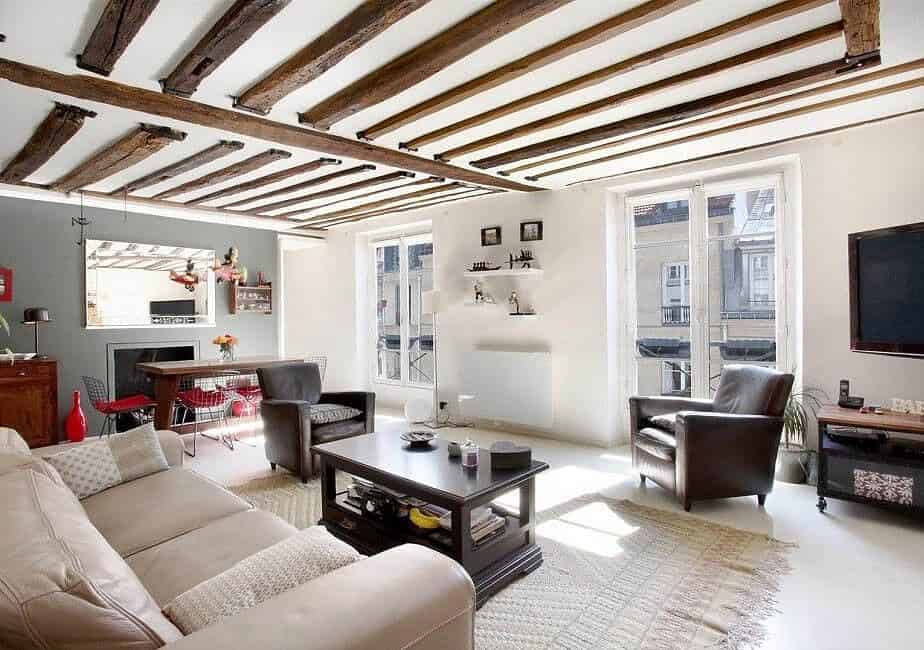
Unfinished ceiling beams in the living room are part of interior design, where beams are used as an unusual element to give the living room itself a certain style and character. In traditional styles, for example, the use of unfinished wooden beams as part of the ceiling construction is commonplace.
Crossed Ceiling Beams
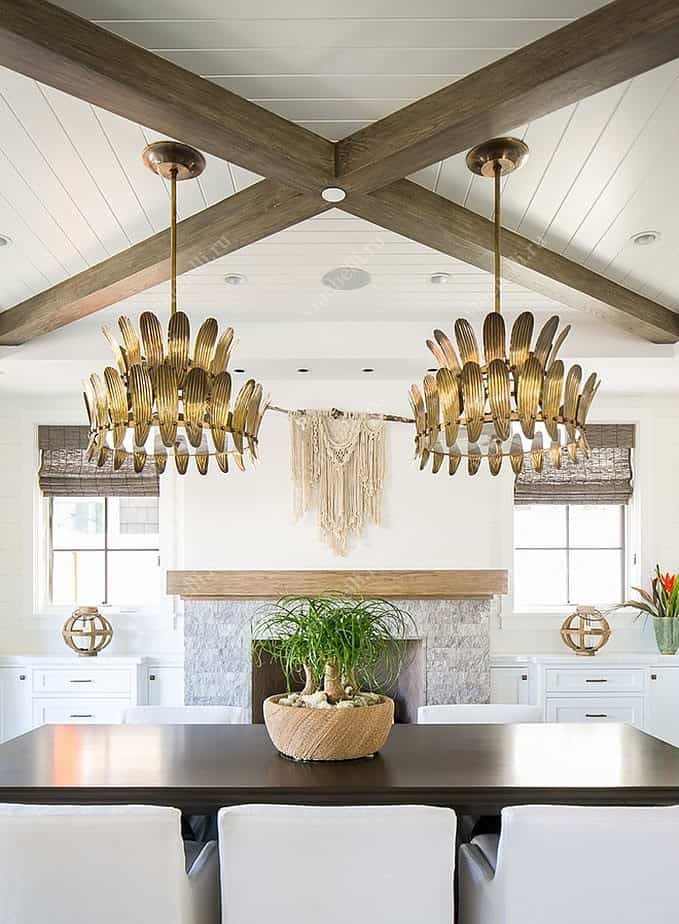
When using crossed ceiling beams in the living room for interior design, you can choose different options and design combinations to get the desired effect. For example, if you want a rustic, country, or rustic kitchen ceiling with decorative ceiling beams, you can use untreated wood beams or beams with a rough surface.
You can also add extra elements, such as wrought iron brackets or rings, to hang light fixtures. You can also experiment with different beam sizes and shapes to get a unique design. For example, you can use a beam of different widths or several beams in various combinations with other elements of the ceiling, such as cornices or skirting boards.
V-Shaped Ceiling Beams
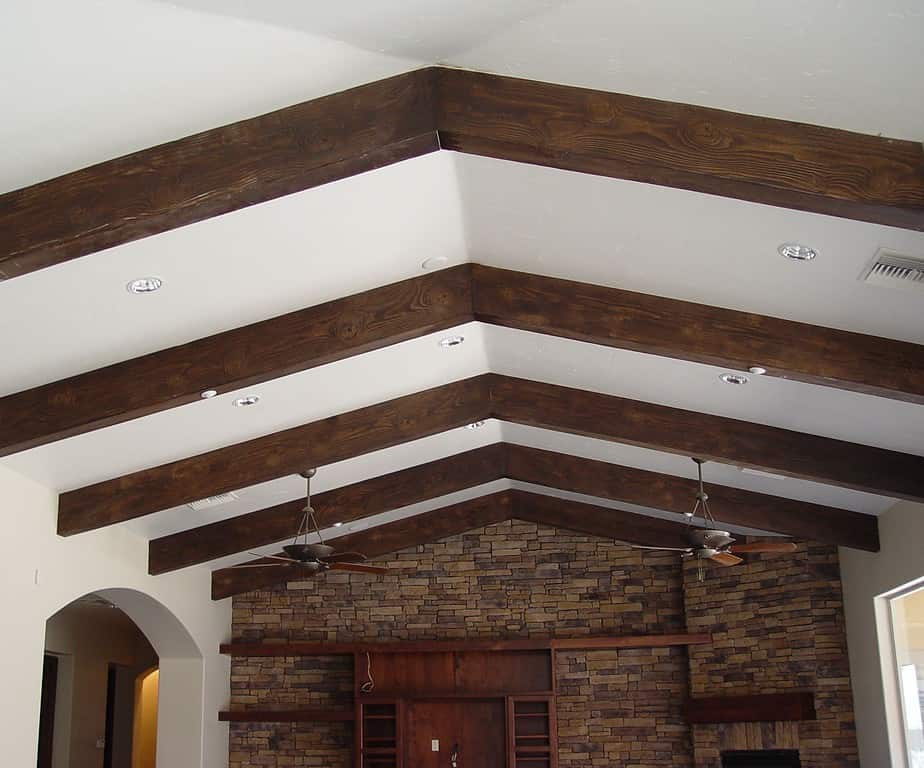
A V-shaped ceiling beam in the living room is a structural element of a wooden, V-shaped ceiling. These decorative ceiling beams are widely used in modern interior design to add spectacular ceiling elements.
The V-beam can also be used to forcibly change the perspective of light in a room, helping to create the visual effect of enlarging the space at the expense of the walls. They can also serve as a ceiling decoration and accentuate the architecture of walls and ceilings in the room.
Herringbone Ceiling Beams
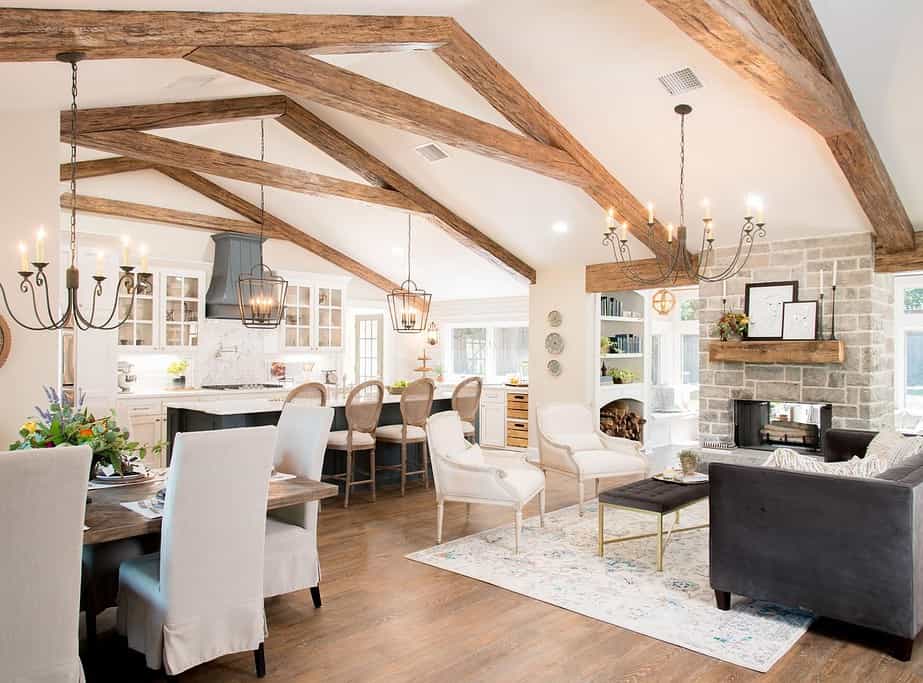
The herringbone is the shape of the ceiling beam in the living and dining room together, which is shaped like a triangle. These ceiling beams are installed on the ceiling in the form of a wooden structure and serve both as a decorative element in the joint design of the living room and dining room, and carry a functional load.
This type of ceiling beam creates a cosy and traditional effect in the bedroom interior. They can also be used as lighting elements, for fixing chandeliers or other lamps.
Double Ceiling Beams
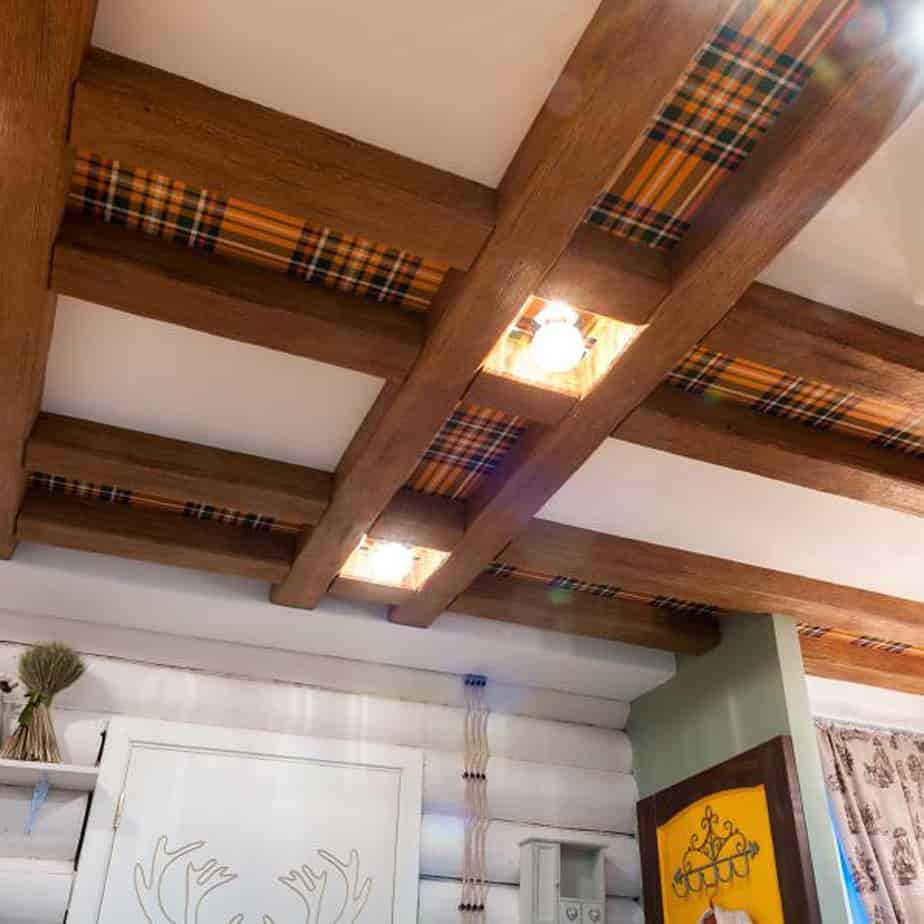
Double ceiling beams are a structural element used in the construction of ceilings. They consist of two or more wooden beams that are positioned parallel to each other at a certain distance and connected to each other. Thermal insulation material may be placed inside the beams to reduce heat loss, light, and noise in the room.
Double joists are highly durable and can withstand high loads, so they can be used to create suspended ceilings of different shapes and sizes.
Sculptural Ceiling Beams
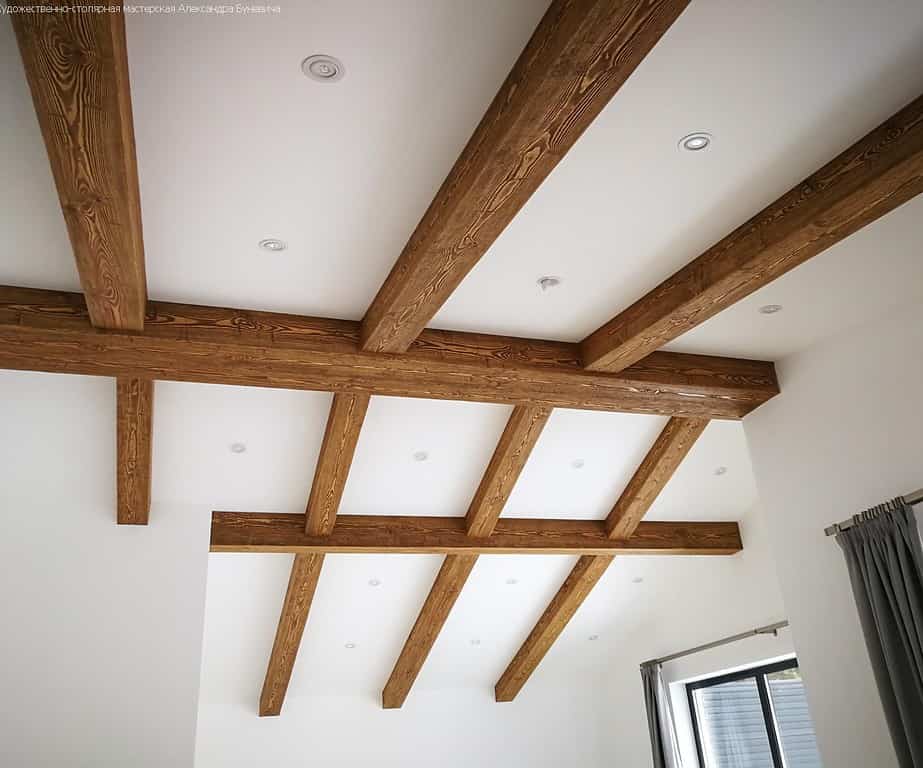
A sculptural ceiling beam is a creative element that is used to create a framing effect and decorate the ceiling. They can be made from different materials, such as natural wood,, plaster, polymers, and others. Sculptural beams can imitate ancient log ceilings or create a modern, stylish design.
They can be designed as through-beams that go through the ceiling, or simply attached to it. The different shapes and sizes of sculptural beams allow a variety of designs to be created to suit the customer’s wishes and the style of the room.
Exposed Wood Beams
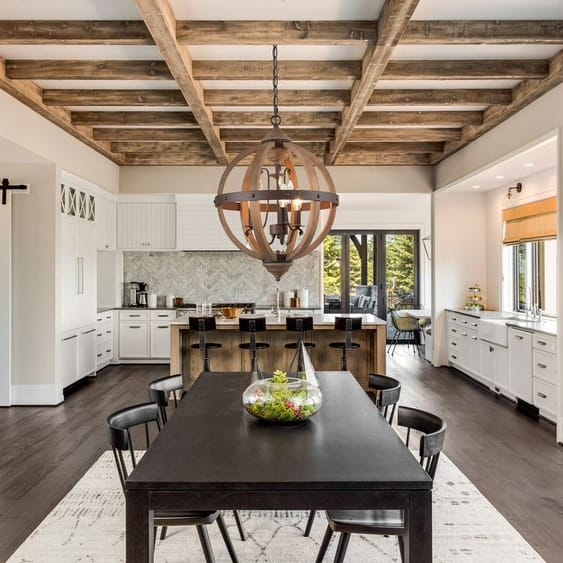
As for the finish of wood itself, there are several options available. Wood beams can be left unfinished or lightly sanded to show the grain of the wood and the natural wood throughout the space.
Wood beams can also be stained or coated with a special protective compound to help keep them in good condition for a long time.If you want to give your wood beam a more aesthetic look, you can use different painting techniques, such as pagination, stucco, glossy, or matte finishes.
In addition, the style and colour of door trim of the wood beams must match the overall interior design concept and create a harmonious composition with the rest of the room.
Painted Ceiling Beams
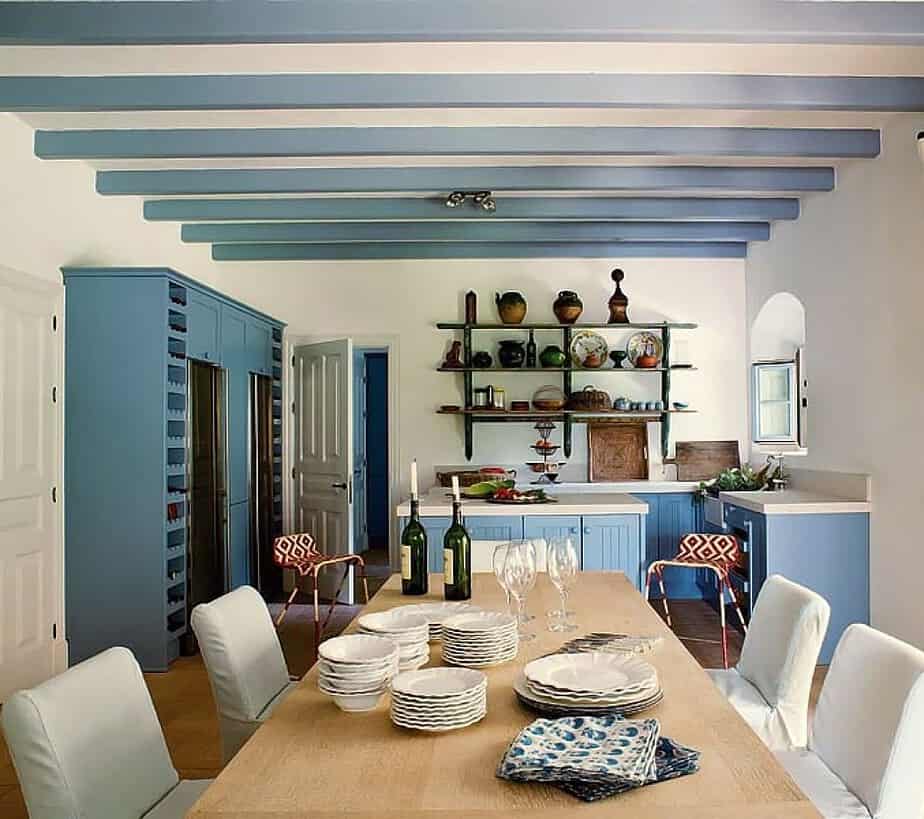
Painted ceiling joists can accentuate color and provide protection against wear and tear. Painting the beams is another option to give them a personal touch and help them blend in with the rest of the room’s decor. A stone fireplace and painted ceiling beams can also be a very attractive combination in an interior.
A stone fireplace adds tradition, warmth, and coziness to a room, while painted ceiling beams can create contrasts and highlight architectural details.
Additionally, painted ceiling beams can also visually lower a high ceiling, making the room feel more intimate and cozy. They can be painted in a variety of colors depending on the desired effect; a light color can brighten up a space, while a dark color can add drama and sophistication.
When choosing to paint ceiling beams, it is important to consider the type of wood they are made from and whether they are already finished or unfinished. Proper preparation and priming will ensure that the paint adheres well and looks smooth and even.
It may also be necessary to fill in any cracks or gaps in the wood before painting. Overall, painted ceiling beams can be a beautiful and unique addition to a room’s design, adding character and charm while also protecting the wood from wear and tear.
Faux Wood Beams
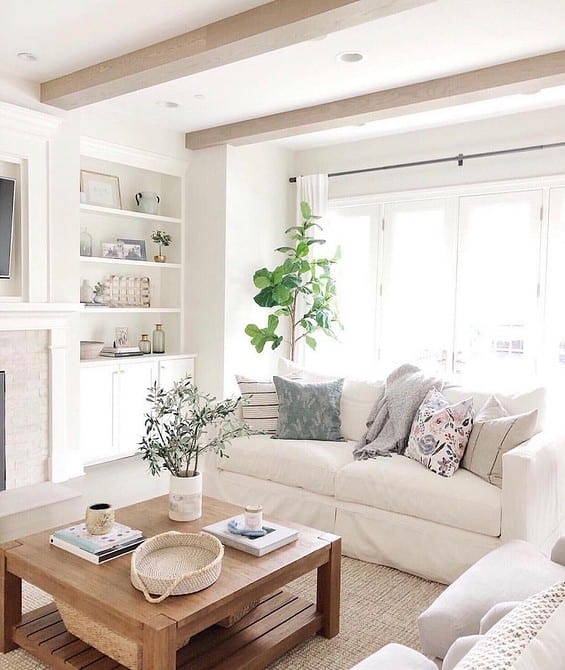
What are Faux Wood Beams? False wooden decorative beams create the effect of real wooden beams on the ceiling, with artificial elements embedded in them. This approach is used when installing real wood ceiling beams is not possible or practical for technical or design reasons. Different materials can be used for creating imitation ceiling beams: faux wood together, plaster, polyurethane, polystyrene, and others.
Depending on the material chosen, the simulation adding ceiling beams can look quite realistic and be indistinguishable from the real beams. It is important to note that the imitation ceiling beams can be a pure element, as well as carry a fun ct.For example, the faux beams can serve as supports for lamps, mirrors, or other interior objects.
Central Beam
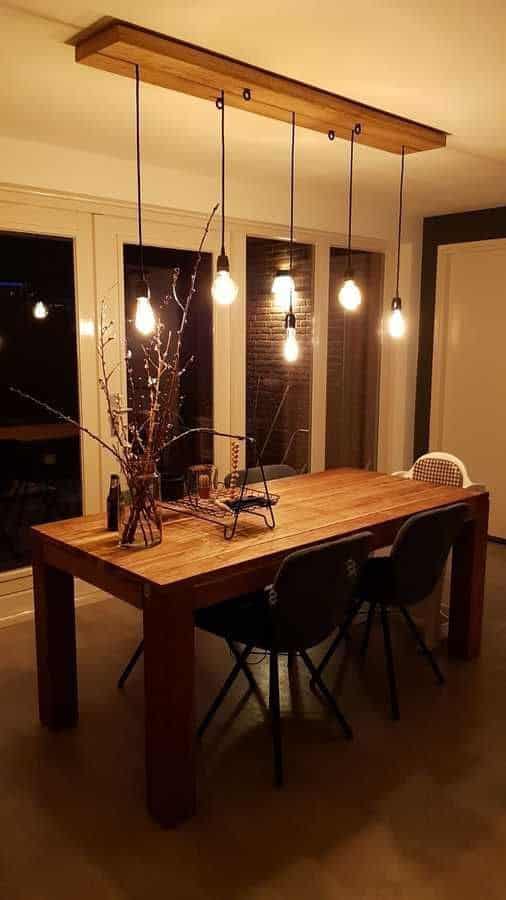
A central beam in ceiling decor can be a very striking element that adds style and a sense of space to a room. It can mimic the supporting structure of the ceiling, giving the impression of greater height, or it can serve a purely decorative function. A central joist can be designed in a variety of styles, from classic to modern.
Wooden beams can imitate a rustic style, while white beams across the width of the island or whole room can imitate a minimalist style. You can also use several of faux dark wood or white cabinets or beams arranged in parallel to each other to create a special effect.In this case, it’s possible to paint each individual beam a different color or decorate them with various elements to achieve an interesting design.
It is important to remember that the central beam can also serve a functional purpose by hiding wires, pipes, and other elements that need to be hidden in the ceiling.
Decorative Wood Beams With A Pattern
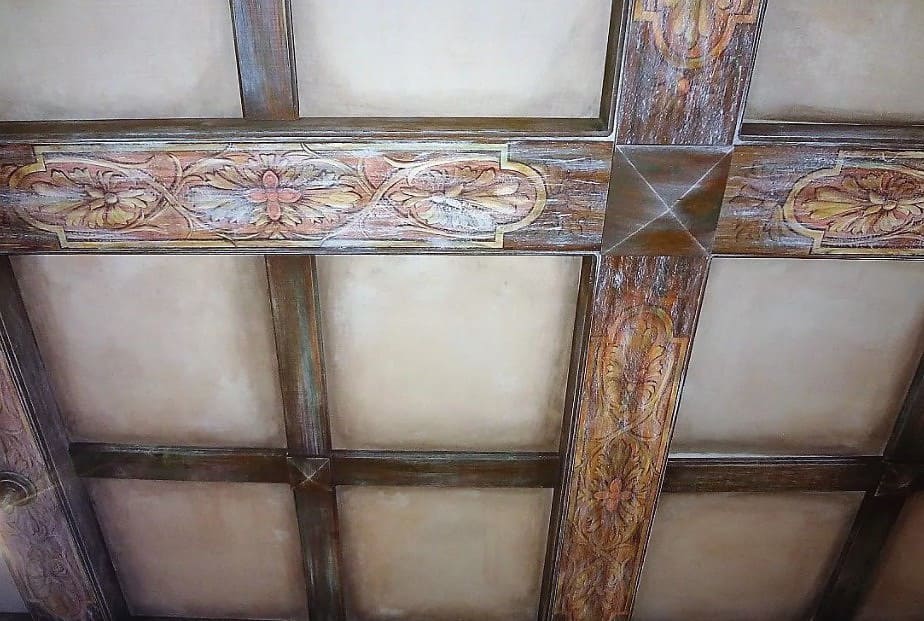
The final choice of pattern for ceiling decorative beams depends on the desired style and design of the room. However, some popular patterns that can be used for ceiling decorative beams include: Chevron: This pattern consists of parallel lines at 45 degrees that intersect to create a zigzag pattern.
Geometric: In this case, the four decorative beams can be arranged in a geometric shape, such as a square or rhombus. Woven imitation techniques can be applied to the decorative ceiling beams themselves to produce a unique pattern.
Conclusion
Advantages Of Ceiling Beams
Visual Interest
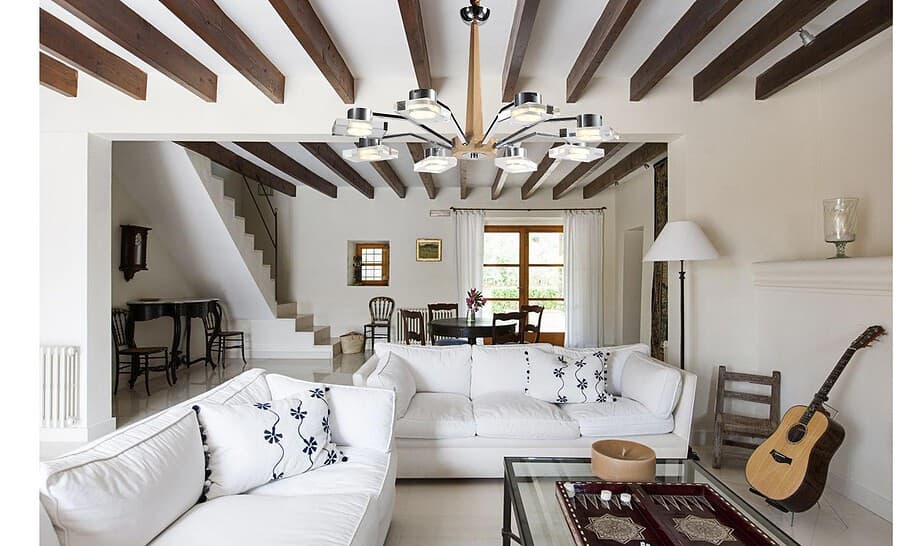
Ceiling beams give the white walls in a room depth, color, and texture, making them visually interesting. In addition, ceiling beams give a room a cozy feel. They can serve as a functional element, e.g., protecting against leaks or supporting the ceiling structure.
Architectural Details

In some homes, ceiling lights can form architectural details and textures on the floor that give a sense of grandeur or old-world charm.
Ceiling lights can serve as a creative element in the home, casting intricate patterns and shadows that add depth and dimension to a space. This can evoke a sense of luxury or a timeless elegance reminiscent of old-world charm.
Height Perception
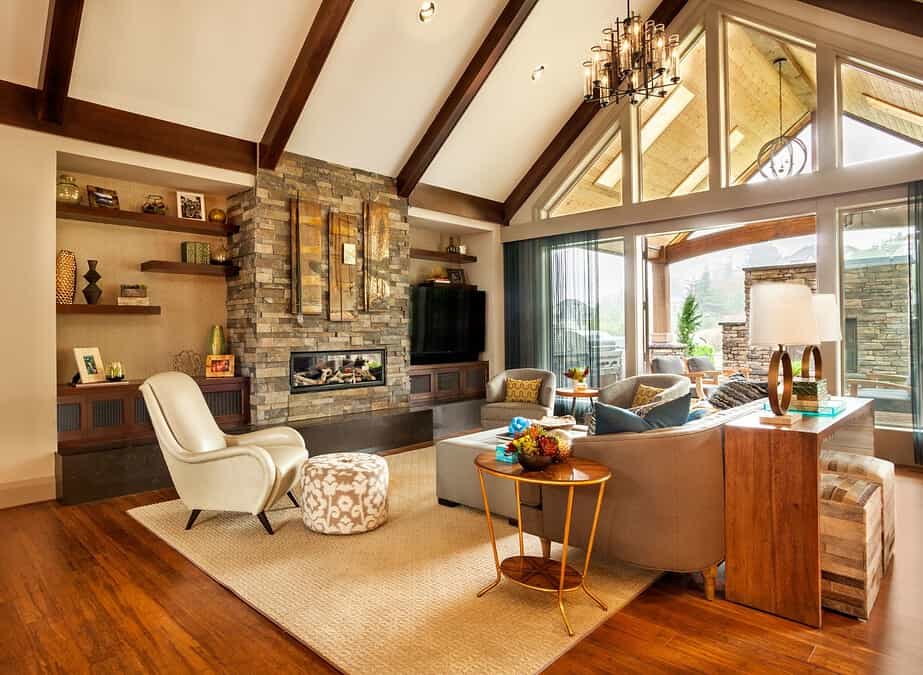
This effect of the higher ceilings visually enlarging the room is achieved by reflecting light off the ceiling surface, raising the ‘plane’ of the ceiling, and making it higher. It can also improve the overall lighting in the room and create a more comfortable atmosphere.
Flexibility
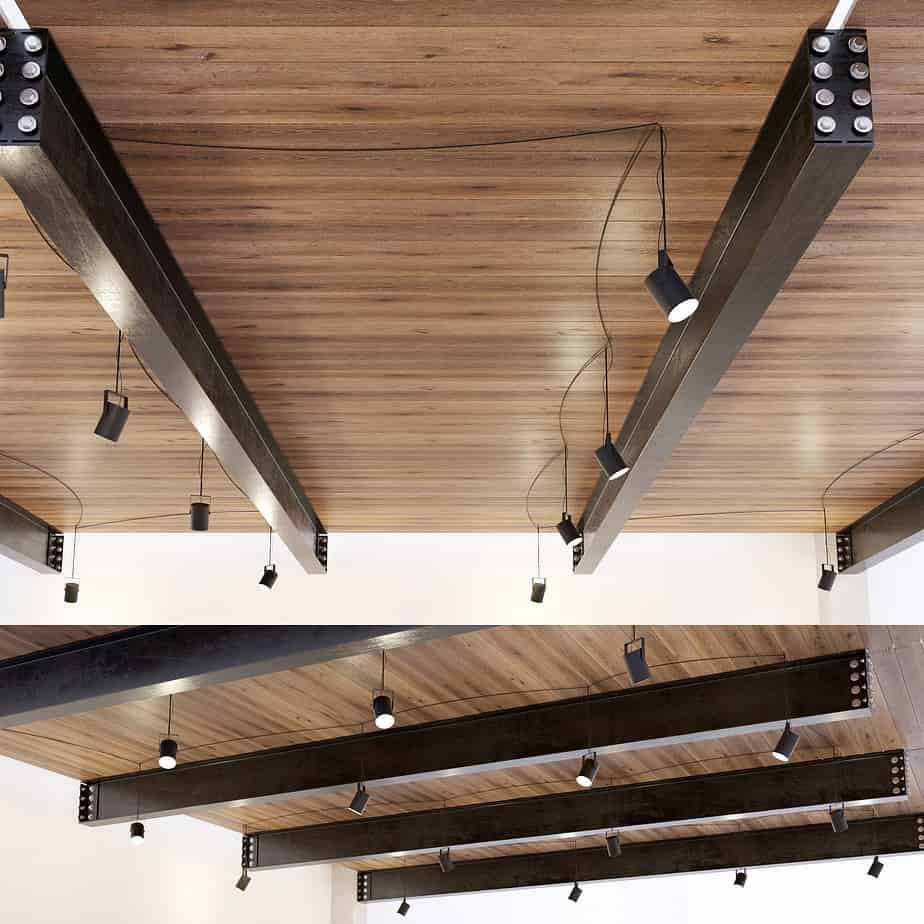
In addition, ceiling beams can serve not only a decorative function, but also help to create a cosy atmosphere in the interior. For example, wooden beams add a natural touch, while metal beams add a contemporary feel. The variety of finishes available allows you to choose the best ceiling beam solution for any interior style.
Hiding

When using wooden beams to conceal exposed pipes and electrical wiring, make sure that they are securely fastened and do not present a danger to others. It is also important to consider safety requirements when choosing materials for masking and to ensure compliance with building regulations. This will help to ensure that the room is not only aesthetically pleasing, but also safe for the occupants.
Recessed Lighting
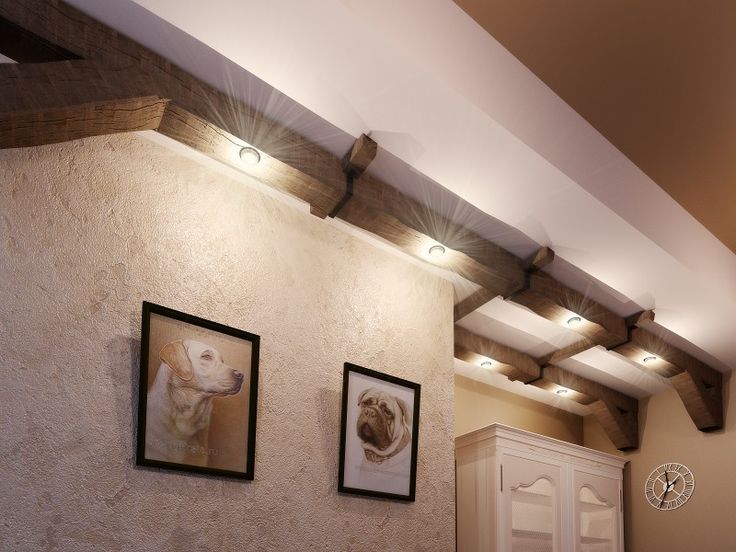
Final Considerations For Designing With Ceiling Beams
When designing with ceiling beams, several final considerations should be taken into account.
First, it is important to make sure that the beams are the right size and spaced at a distance in accordance with the loads they will withstand.
It is also critical to consider how the beams will fit into the overall aesthetics of dining space and the design of the room, and whether they will complement or contradict the space with other architectural features or decorative elements.
If you’re interested:
Basic Properties Of Wood Materials That Beginners Should Know
11 Most popular questions to find the best belt sander
Here Is Everything You Need To Know About Varnish and PU Paint